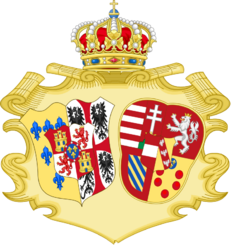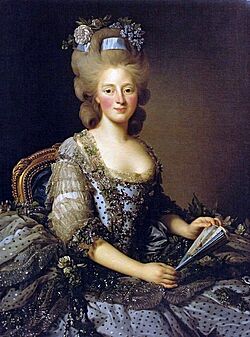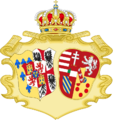Maria Amalia, Duchess of Parma facts for kids
Quick facts for kids Maria Amalia |
|||||
|---|---|---|---|---|---|
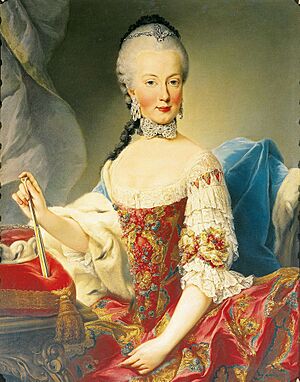
Maria Amalia, probably by Martin van Meytens; 1760s
|
|||||
| Duchess consort of Parma, Piacenza and Guastalla | |||||
| Tenure | 19 July 1769 – 9 October 1802 | ||||
| Born | 26 February 1746 Hofburg, Vienna, Archduchy of Austria, Holy Roman Empire |
||||
| Died | 18 June 1804 (aged 58) Prague Castle, Prague, Kingdom of Bohemia, Holy Roman Empire |
||||
| Burial | St. Vitus Cathedral, Prague | ||||
| Spouse |
Ferdinand I, Duke of Parma
(m. 1769; died 1802) |
||||
| Issue among others... |
|
||||
|
|||||
| House | Habsburg-Lorraine | ||||
| Father | Francis I, Holy Roman Emperor | ||||
| Mother | Maria Theresa | ||||
Maria Amalia (born February 26, 1746 – died June 18, 1804) was a powerful duchess. She became the Duchess of Parma, Piacenza and Guastalla by marrying Ferdinand I, Duke of Parma. She was born an archduchess in Austria. Her parents were Empress Maria Theresa and Emperor Francis I.
Contents
Growing Up in Austria
Maria Amalia, often called Amélie, was born on February 26, 1746. Her birthplace was the Hofburg palace in Vienna, Austria. She was the eighth child of Maria Theresa, who ruled the Habsburg monarchy, and Emperor Francis I, Holy Roman Emperor. She spent her childhood in and around Vienna. In winter, she lived at the Hofburg. During summer, she stayed at Schönbrunn Palace and Laxenburg castles.
Her Childhood and Hobbies
Maria Theresa had sixteen children. They were usually raised in groups of two, based on their age and gender. However, Maria Amalia was born between two boys. This meant she grew up almost like an only child. She was taught how to be a good royal wife. This included learning arts and how to be proper and polite. As a child, she was smart but also a bit stubborn.
From a young age, she loved hunting. Her father often took her on his hunting trips when she was just six years old. This hobby became a lifelong passion for her. She also loved nature and animals. Maria Amalia had a difficult relationship with her mother. Maria Theresa seemed to have the hardest time with Maria Amalia compared to her other daughters. When Maria Amalia became an adult, she was very popular in Vienna society because of her beauty.
A Royal Marriage
As a young adult, Maria Amalia became a strong and independent woman. She didn't always agree with her mother's plans. In 1767, she fell in love with Prince Charles of Zweibrücken. He was next in line to rule several German lands. But her mother, Maria Theresa, and her chief minister, Prince Kaunitz, didn't think he was a good match. They refused his marriage proposal. Maria Amalia protested, but she had to accept her mother's decision.
At this time, talks were already happening about Maria Amalia marrying Ferdinand I, Duke of Parma. He was a cousin of King Charles III of Spain. Empress Maria Theresa hoped this marriage would help Austria gain more influence in Italy. Maria Amalia's older brother, Joseph II, Holy Roman Emperor, supported the marriage. His first wife had been Ferdinand's sister. This marriage was one of several between Maria Theresa's daughters and members of the House of Bourbon.
Ferdinand was five years younger than Maria Amalia. He was known for being very religious and enjoying simple things. He liked ringing church bells and roasting chestnuts with local farmers. When Maria Amalia learned about her future husband, she was very upset. Maria Theresa promised her a large dowry (money or property given by the bride's family) and payments from the Spanish court. Still, Maria Amalia did not want the marriage.
The wedding was planned for late 1768. But it was delayed several times. The Pope at the time refused to allow the marriage because of disagreements with the Bourbon family. When that Pope died in 1769, the new Pope quickly approved the marriage. A proxy wedding (where someone stands in for the groom) took place in Vienna in June 1769. Maria Amalia's younger brother, Ferdinand, represented the groom. Maria Amalia looked tired and stressed during the celebrations. She never forgave her mother for forcing her into this marriage.
Duchess of Parma
Maria Amalia left Austria on July 1, 1769. Her brother, Joseph II, went with her. She married Ferdinand on July 19 at the Ducal Palace of Colorno. Her mother had told her to be obedient and to fit in with local customs. She was also told not to get involved in politics.
The Duchy of Parma was largely controlled by France at the time. A minister named Guillaume du Tillot managed things. He kept Ferdinand out of politics. The King of France, Louis XV, also supported du Tillot. Maria Amalia's marriage was meant to change Parma's pro-French policy. It was hoped to bring Parma closer to Austria and Spain. When Maria Amalia arrived, she was expected to follow du Tillot's wishes. But he was suspicious of her, and this immediately caused problems.
In 1771, Maria Amalia managed to have du Tillot removed from his position. She replaced him with a Spanish official. But in 1772, Maria Amalia fired that official too. She then chose an Italian prime minister and a group of local officials. These officials were loyal to her, not to a foreign ruler. This way, she made sure Parma would not be controlled by Spain. Duke Ferdinand was happy to focus on his religious duties and raising his children. He left all government matters to his wife. After these changes, Maria Amalia became the true ruler of Parma.
In 1773, her mother, Empress Maria Theresa, sent an ambassador to Parma. He was supposed to advise Maria Amalia. But Maria Amalia told him she didn't want letters from Vienna or Madrid anymore. After this, Parma's diplomatic ties with Austria and Spain were cut.
As the ruler of Parma, people called Maria Amalia La Mata or La Signora (The Lady). She worked to keep Parma independent. She also helped strengthen its sense of nationality and supported art, culture, and literature. She worked well with her ministers. Ferdinand had little political power. Maria Amalia often changed his orders and made him sign state documents for her. She even included her name in his orders, as if they ruled together.
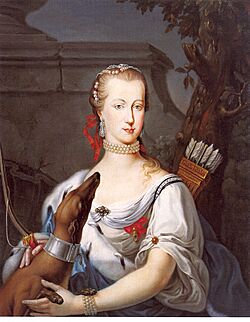
Maria Amalia's personal life caused some talk. She didn't hide her unhappiness with her husband or her new life. She used money from her mother for fancy clothes, a grand court, and parties. She replaced most of her ladies-in-waiting with a group of handsome men from the royal guards. She sometimes dressed in men's clothes. She would go out alone at night and visit officers' clubs. While Ferdinand had relationships with women from the countryside, she had relationships with members of his guard. This worried her mother, who feared it would harm the reputation of Maria Amalia's younger sisters, especially Maria Antonia, who was to marry the future King of France.
Maria Amalia and her husband never had a close relationship. However, they were both loving parents. The nobles in Parma did not like her much. They thought she lived too luxuriously for such a small state. Maria Amalia, in turn, thought they were not helpful to Parma. But she was popular with ordinary people because she was generous to the poor. At her famous parties, she had tables set up for both nobles and poor guests, and everyone ate the same food.

Maria Amalia remained distant from her mother. They had a brief reconciliation in 1773 when her first son was born. But Maria Amalia continued to resist her mother's attempts to control her. Her sister, Maria Christina, visited Parma in 1775. She told their mother that Maria Amalia had lost some of her beauty and cheerfulness. Maria Amalia kept in touch with her younger sisters, Marie Antoinette (Queen of France) and Maria Carolina of Austria (Queen of Naples and Sicily). The three sisters exchanged letters and gifts. One of Marie Antoinette's last letters from prison was written to Maria Amalia. However, Maria Amalia's disagreements with their mother strained her relationships with her other siblings.
In 1778, her oldest son, Prince Louis, hurt himself. He hit his head on a marble table while playing. He recovered from a serious injury, but after this, he had epileptic seizures and was often confused. This difficult time helped Maria Amalia and Ferdinand get along better. In the 1780s, Ferdinand also became more interested in state matters. The well-being of Parma became a shared interest, which improved their relationship.
Later Life and Challenges
In May 1796, during the French invasion of Italy led by Napoleon Bonaparte, French troops entered the Duchy of Parma. Maria Amalia strongly disliked the French, especially after her sister Marie Antoinette was executed. Ferdinand, however, was unsure because he was half French. Napoleon offered not to conquer Parma if they allowed French troops to pass through. When he received no answer, he offered Ferdinand the island of Sardinia (which he didn't control) in exchange for Parma. When Ferdinand refused, Napoleon sent French troops to occupy Parma. He forced Ferdinand to agree to the French terms. Ferdinand and Maria Amalia were allowed to keep their titles, but they were guarded by the French. The duchy was ruled by French officials, and its taxes were used to pay for the French army.
In February 1801, under the Treaty of Lunéville, the Duchy of Parma was taken over by a new French-controlled state called the Kingdom of Etruria. This new kingdom was given to Maria Amalia's son, Louis, who was married to a Spanish princess. Both Ferdinand and Maria Amalia were against this treaty. An agreement was made that the duchy would not be fully taken over until Ferdinand's death. The new French governor of Parma placed them under house arrest. Maria Amalia reportedly worried about her husband's safety.
On October 9, 1802, Maria Amalia was named head of a regency council. This council was set up by the dying Ferdinand. Her official rule as regent lasted only a short time. On October 22, 1802, the French took over the duchy completely and forced her to leave Parma. People thought Ferdinand might have been poisoned. There were rumors that Maria Amalia poisoned him to regain power, but also that Napoleon's spies had poisoned him.
Widowhood and Death
Maria Amalia attended her husband's funeral procession with their daughters. Her nephew, Francis II, Holy Roman Emperor, allowed her to live in Prague Castle. She moved there with her two youngest daughters, Maria Antonia and Maria Carlotta, and a small group of servants. At Prague Castle, she suffered from sadness. She never fully recovered from the execution of her sister Marie Antoinette, whom she mourned for the rest of her life. Her two oldest children, Carolina and Louis, also died before her, which made her sadness worse. She died in 1804 from breast cancer after several colds. Her sisters Maria Elisabeth and Maria Carolina tried to visit her before she died, but they did not arrive in time. Her body was buried in the royal crypt of St. Vitus Cathedral in Prague. Her heart was taken to Vienna and placed in her family's Herzgruft (Heart Crypt).
Her Children
Maria Amalia and her husband Ferdinand had nine children:
| Children of Maria Amalia of Austria by Ferdinand of Parma | ||||
|---|---|---|---|---|
| Name | Picture | Birth | Death | Notes |
| Carolina Maria Teresa Giuseppa Giovanna |  |
Ducal Palace of Colorno, 22 November 1770 | Dresden Castle, 1 March 1804 | She married Maximilian, Hereditary Prince of Saxony in 1792. They had eight children. |
| Ludovico Filiberto Francesco |  |
Ducal Palace of Colorno, 5 July 1773 | Palazzo Pitti, Florence, 27 May 1803 | He was the Prince of Piacenza and the first King of Etruria. He married Princess Marie Louise of Spain in 1795. They had two children. |
| Maria Antonia Giuseppa Walburga Anna Luisa Teresa Vicenza Margherita Caterina |  |
Ducal Palace of Colorno, 28 November 1774 | Convent of Sant'Agata in Trastevere, Rome, 20 February 1841 | She was engaged to a prince who died. She became a nun in 1803 and was known as Sister Luisa Maria. |
| Maria Carlotta Ferdinanda Teresa Anna Giuseppa Giovanna Luisa Vincenza Rosalia |  |
Palazzo del Giardino, 1 September 1777 | Convent of Santi Domenico e Sisto, Rome 6 April 1813 | She became a nun in 1797 and was known as Sister Giacinta Domenica. |
| Filippo Maria Giuseppe Leopoldo Francesco | Ducal Palace of Piacenza, 22 March 1783 | Ducal Palace of Colorno, 2 July 1786 | He was the Prince of Guastalla. He died at three years old from scurvy. | |
| Maria Antonietta Luisa Teresa | Ducal Palace of Colorno, 21 October 1784 | Ducal Palace of Colorno, 22 October 1785 | She died at one year old from smallpox. | |
| Maria Luisa Teresa Isabella Antonietta | Ducal Palace of Piacenza, 17 April 1787 | Palazzo del Giardino, 22 November 1789 | She died at two years old from pleurisy. | |
| Son | 21 May 1789 | 21 May 1789 | Stillborn. | |
| Daughter | 21 May 1789 | 21 May 1789 | Twin of the above, stillborn. | |
Images for kids
-
Maria Amalia as Diana on Carlo Angelo dal Verme's portrait
-
Maria Amalia's children in 1779 on a painting by Johan Zoffany



